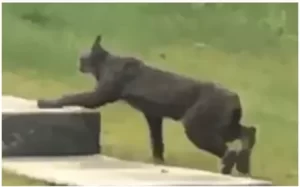Jung reports that the lynx featured in the movie exhibits a rare coat coloration, characterized by a diverse range of hues. Unlike the typical black coat containing whitish gray guard hairs found in many lynx species, this particular individual showcases a variety of colors across its coat, including reddish brown, silvery gray, and black.
While most lynx species tend to display similar coloring, the Canada lynx, in particular, is often observed with silvery gray coats during winter, which contrasts with the reddish-brown hues more prevalent in summer.
According to Jung, such variations in coat coloration among lynx populations can serve as adaptations that may either aid (adaptive) or hinder (maladaptive) evolutionary processes.
Although scientists have yet to determine whether melanism in animals provides advantages or disadvantages, Jung suggests that the lynx’s melanistic feature could be maladaptive due to its potential impact on camouflage. In winter, the darker hair of the lynx might make it more conspicuous against the snowy backdrop, possibly compromising its hunting abilities.









